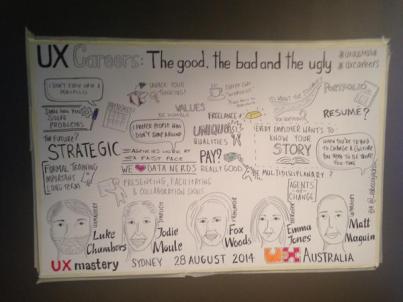UXAustralia 2014 reflections

UXAustralia in Sydney seemed to be a bigger event than what I have experienced in the other capital cities. More people, more presentations, more vendors, more rooms and levels.
To be fair, I haven’t counted or compared numbers (Donna, Steve, if you read this please feel free to confirm or deny) but it certainly felt bigger than the last two. We were treated to a third room over the two days that featured longer, workshop style sessions. I really loved this format. It meant that if you chose you could do a lovely deep dive into a particular topic area with some great variety to choose from.
It’s always hard after a conference to reveiew in detail every single presentation, so I’ll talk about some high level themes and bits that really stuck with me instead.
Design workshop
My conference agenda started with a workshop on the Wednesday with Samantha Soma. I have been doing a lot of design work with groups in my recent project work and was looking forward to some tools to help make the design process a bit smoother. While on the day it wasn’t what I had expected, on reflection I got exactly that. Samantha led us through a number of experiential exercises in our groups with the purpose of working through conflict and difficulties that arise in the design process. I found it very helpful and someone cathartic to share with my small group through the process and also hear about some of their difficulties in past projects. I left the workshop with some actions to take back to the office (that I plan to implement) and some really handy tools that I will use again. I look forward to digging into to some of Samantha’s recommended reading and understanding more of the theory.

Democratisation of design
What became a recurring theme of the conference was established early on in the keynote presentation. Greg Petroff sowed the seed when he spoke about spreading UX like a contagion. The difficulty in getting clients/customers/colleagues to understand the value of user experience design seemed to be a common struggle for UX designers, and those of us who have UX as part of their role. So perhaps instead of trying to lock things down, govern and centralise we should look to spread design acumen like a contagion through organisations and the community. Optimal workshop did a great post about UXAustralia which included a number of great quotes from delegates. I think the following quote demonstrates the need for democratisation of design.
Making my stakeholders aware of the need and the benefit of UX work in the first place…
Networking and careers
I really liked the introduction of the UX trading cards to encourage networking. I always find networking tough, especially at events this size, the trading cards gave everyone a great excuse to approach each other and start conversation.

UXMastery ran a UX careers panel on day one of the conference, with an exellent panel of speakers who had ranging UX experience. The room was packed, and majority of attendees identified as being new to user experience design. There were as many clear insights as there were contradictions in the panel’s opinions. The one thing that stood out for me, was that it is important for us to be able to tell our story to prospective employers, about our work and us as people.

It’s all in our head
Two of my favourite presentations focused more on the cerebral side of user experience. Stephen Cox talked about the neuroanthropology of us, how our brains are changing all the time and that designing with an acknowledgement of social context and our connections will make for better design. I really enjoy some of the more academic presentations that discuss the science and how it relates in practice. Sarah Lloyd spoke about Tools for UX creativity how our ability to scan the brain has increased our understanding of how it works, including the ability to capture and recall things, and where our motivations come from.
From the field
I wasn’t sure what to expect from Steve Portigal’s war stories. It was shocking, intriguing and funny. While we certainly get war stories working in enterprise, I had not ever heard stories from the field like Steve shared in his presentation. For me it caused brought perspective, I imagine for others it brings the comfort that you aren’t the only one. I encourage you to check out the war stories blog.
There were a heap of great case studies at the conference as usual. Gerry Gaffney and Julian Huxham had great advice from their jury management service case studys including understanding the problem before purchasing, have a clear narrative for business buy in and keeping an eye on the detail. Richard Perdriau and Jolanda Zerbst shared Vic Road’s case study about their responsive website and a number of really practical tips for responsive design such as ensuring a collaborative process and designing mobile and desktop together.
Final thoughts
I came back to the office with so many great tips and ideas which I have already started implementing. I got to catch up with many of my existing UX friends and met a pile of new ones over the three days I was there. I can’t ask for much more from a conference than to come away inspired and full of information and ideas.
If you didn’t make the conference they are running a redux event in both Sydney and Melbourne this year (5 November and 29 October respectively). It’s a cut down version of the big event at a bargain price and worth checking out.






Lovely summary, thanks. Yes, it was bigger than previous conferences – 100 more than last year. I think there is a tipping point between a 500 person conference and a 600, so we did some extra things to help folks get over the ‘holy crap, there are a lot of people here and I don’t know anyone’ feeling, though our desires were a bit restricted by what we could do in the venue (which is always the case).